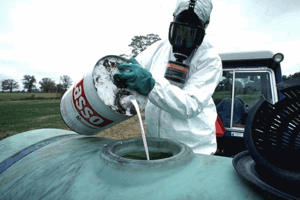Environmental Groups vs. EPA
Air Date: Week of January 28, 2011

Creatures like the California Condor are critically endangered, and this lawsuit states that some pesticides might harm such animals. (Wikimedia Creative Commons)
Two environmental groups filed a federal lawsuit claiming that the Environmental Protection Agency is not doing enough to protect threatened and endangered species. Host Bruce Gellerman talks with West Palm Beach attorney Keith Rizzardi about the lawsuit’s implications.
Transcript
GELLERMAN: Two environmental organizations have launched a federal lawsuit designed to protect over two hundred endangered species from commonly used pesticides. But if the suit is successful it could have a profound effect on the nation’s farmers and you. The Center for Biologicial Diversity and Pesticide Action Network charge that the U.S. EPA has violated the Endangered Species Act.
The groups allege the EPA was required to consult with other federal agencies regarding the impacts of pesticides on threatened species - but never did. West Palm Beach attorney Keith Rizzardi has been following the federal suit - he writes a blog about the Endangered Species Act. Mr. Rizzardi welcome to Living on Earth!
RIZZARDI: Thank for having me.
GELLERMAN: Now, we should say that you’re not part of this lawsuit.
RIZZARDI: Not at all.
GELLERMAN: This thing is, what, 400 pages long and the EPA basically is charged with failing to follow the federal rules.
RIZZARDI: Yes, it’s a very significant law suit. And if it were to go to the merits, it would have significant consequences for how pesticides are administered in the nation.
GELLERMAN: In this lawsuit what they’re charging is that there are 300 pesticides that violated the Endangered Species Act.
RIZZARDI: Yeah, three to four hundred different pesticides are identified, over 200 different species are identified, you know, if you do the permutations, you could be talking about 80,000 combinations. And by my best guess, this lawsuit suggests that about 27,000 different analyses are needed.
GELELRMAN: Well, the EPA knows its own rules - how could they have not followed them for this long?
RIZZARDI: I don’t think the question here is how could EPA have not complied with the law. They did comply with all their responsibilities under the federal Insecticide, Fungicide and Rodenticide Act. And in fact, this lawsuit says, it’s not about IFRA, it’s about the Endangered Species Act. The concern being raised in the complaint is that the Center for Biological Diversity simply believes is what EPA is already doing is not enough.

Creatures like the California Condor are critically endangered, and this lawsuit states that some pesticides might harm such animals. (Wikimedia Creative Commons)
GELLERMAN: And that layer of analysis is that they should have gone to other federal agencies and asked them how it is affecting endangered species?
RIZZARDI: Yes, and as President Obama joked in his State of the Union Address, it could be both the National Marine Fisheries Service and the US Fish and Wildlife Service depending on which species you may be talking about.
GELLERMAN: I understand that this is not the first time that the EPA has been sued on this issue, and sued successfully.
RIZZARDI: That’s true, there have been other lawsuits brought by the Center for Biological Diversity involving pesticides and other species. It happened with the California gnat catcher, it also happened with Pacific Northwest salmonid species.
GELLERMAN: And the environmental groups won.
RIZZARDI: Or a settlement was achieved, yes sir.
GELLERMAN: Given that the EPA has settled in past cases regarding this, how come they have to face yet another lawsuit?
RIZZARDI: Well, one thing that’s important to keep in mind is that the Environmental Protection Agency is not the ultimate authority on threatened and endangered species. The consulting agencies are the US Fish and Wildlife Service and the National Marine Fisheries Service. And those are the agencies whose roles are at issue. And the question is raised in this lawsuit is whether EPA had a duty and should have gone back and talked to those agencies about the consequences of the pesticides for these given species.
GELLERMAN: Um, my sense is that this lawsuit could have extraordinary broad implications. I was reading, you know, something that the executive director of the Kansas Corngrowers Association said that - and he said - this is more of an assault on modern agriculture than it is about protection of endangered species.

A cropduster plane spraying a field with pesticides. (Wikimedia Creative Commons)
RIZZARDI: It’s true that this lawsuit could have very significant nation-wide consequences. And could indeed lead to a significant re-write of the way that many of our pesticides are used. One of the things to understand about the Endangered Species Act is that it was meant to be the Noah’s Ark of environmental law. It was supposed to be a last resort and a way, when it was originally created, for federal agencies to take a real careful look at their proposed actions. And evaluate them with respect to individual species before they took them. And one thing about the law here is that it adopts the precautionary principle.
It says in all cases do no harm to the species, and in some cases it talks about erring in favor of the species when you have concerns. But what you’re seeing here is the continued evolution of the Endangered Species Act and the use of the Endangered Species Act sort of as a policy proxy and a surrogate for other things. And in this case it could possible function as something of a surrogate for FIFRA reform- the Federal Insecticide Fungicide and Rodentide Act.
By way of example, let me take you back to the lawsuit in the Pacific Northwest. The biological opinion that ultimately got issue found that some of the pesticides were likely to jeopardize the continued existence of some of the salmon species. As a result, the National Marine Fisheries Service imposed some additional conditions on how those pesticides could be used, such as wind speed restrictions - when the wind is blowing higher than a certain rate, you shouldn’t be applying the pesticides.
They put restrictions on moisture - they said that when it’s really wet, it’s likely that that pesticide will have an easier time of getting into the watershed, so you can’t use it then. They created fish mortality reporting requirements, and they created habitat monitoring reporting requirements - all of that grew out of the Endangered Species Act, and were additional requirements that went above and beyond what was previously being required under the FIFRA terms.

Preparing for pesticide spraying. (Wikimedia Creative Commons)
GELLERMAN: So, take a lawyerly position. If you were a government attorney trying to defend against this lawsuit, what would be your response.
RIZZARDI: Every case is very fact-specific, and requires you to take a very good look at the record. And the record is an administrative record, it’s the whole history of what the federal government has done on a given issue. And barring having that set of documents in front of me, I’m not sure what position I’d take right now, but I can say looking at it, yeah, I’d be nervous!
GELLERMAN: Well, Mr. Rizzardi, thank you very much, I really appreciate it.
RIZZARDI: Bruce, it was really wonderful talking with you.
Links
Visit Keith Rizzardi’s Endangered Species Act blog
Living on Earth wants to hear from you!
Living on Earth
62 Calef Highway, Suite 212
Lee, NH 03861
Telephone: 617-287-4121
E-mail: comments@loe.org
Newsletter [Click here]
Donate to Living on Earth!
Living on Earth is an independent media program and relies entirely on contributions from listeners and institutions supporting public service. Please donate now to preserve an independent environmental voice.
NewsletterLiving on Earth offers a weekly delivery of the show's rundown to your mailbox. Sign up for our newsletter today!
 Sailors For The Sea: Be the change you want to sea.
Sailors For The Sea: Be the change you want to sea.
 The Grantham Foundation for the Protection of the Environment: Committed to protecting and improving the health of the global environment.
The Grantham Foundation for the Protection of the Environment: Committed to protecting and improving the health of the global environment.
 Contribute to Living on Earth and receive, as our gift to you, an archival print of one of Mark Seth Lender's extraordinary wildlife photographs. Follow the link to see Mark's current collection of photographs.
Contribute to Living on Earth and receive, as our gift to you, an archival print of one of Mark Seth Lender's extraordinary wildlife photographs. Follow the link to see Mark's current collection of photographs.
 Buy a signed copy of Mark Seth Lender's book Smeagull the Seagull & support Living on Earth
Buy a signed copy of Mark Seth Lender's book Smeagull the Seagull & support Living on Earth

